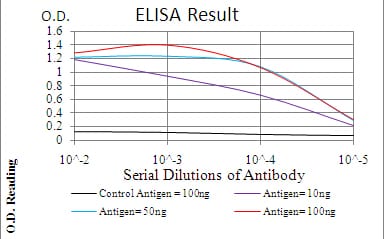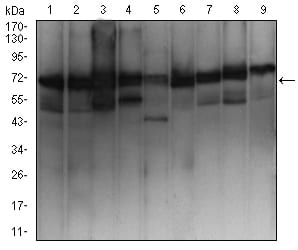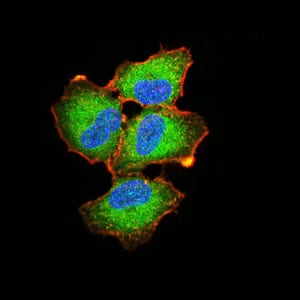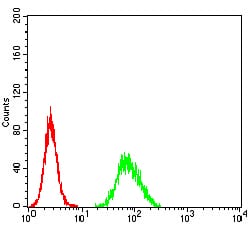




| WB | 1/500 - 1/2000 | Human,Mouse,Monkey |
| IF | 咨询技术 | Human,Mouse,Monkey |
| IHC | 咨询技术 | Human,Mouse,Monkey |
| ICC | 1/100 - 1/400 | Human,Mouse,Monkey |
| FCM | 1/200 - 1/400 | Human,Mouse,Monkey |
| Elisa | 1/10000 | Human,Mouse,Monkey |
| Aliases | CVL; CVIL; VIL2; HEL-S-105 |
| Entrez GeneID | 7430 |
| clone | 6F1A9 |
| WB Predicted band size | 69.4kDa |
| Host/Isotype | Mouse IgG1 |
| Antibody Type | Primary antibody |
| Storage | Store at 4°C short term. Aliquot and store at -20°C long term. Avoid freeze/thaw cycles. |
| Species Reactivity | Human,Mouse,Monkey |
| Immunogen | Purified recombinant fragment of human EZR (AA: 292-464) expressed in E. Coli. |
| Formulation | Purified antibody in PBS with 0.05% sodium azide |
+ +
以下是3篇与EZR(Ezrin)抗体相关的文献摘要,供参考:
---
1. **文献名称**:*Ezrin as a prognostic marker and therapeutic target in breast cancer*
**作者**:Clucas J, Valderrama F
**摘要**:该研究探讨Ezrin蛋白在乳腺癌转移中的作用,通过免疫组化分析发现Ezrin高表达与肿瘤侵袭性及不良预后显著相关。实验中使用特异性EZR抗体验证其在细胞膜-细胞骨架信号传导中的功能,提示Ezrin可能成为治疗靶点。
---
2. **文献名称**:*The role of Ezrin in gastrointestinal stromal tumors*
**作者**:Faisal MG, Hirota S
**摘要**:研究通过Western blot和免疫荧光技术(使用EZR单克隆抗体)分析胃肠道间质瘤(GIST)中Ezrin的表达模式,发现其表达水平与肿瘤大小及转移风险相关,表明Ezrin可能作为GIST的潜在诊断标志物。
---
3. **文献名称**:*Ezrin regulates the osteosarcoma cell metastasis via ERK pathway*
**作者**:Khanna C, Wan X
**摘要**:该研究利用基因沉默技术和EZR抗体检测,证明Ezrin通过调控ERK信号通路促进骨肉瘤细胞的迁移和侵袭,提示靶向Ezrin可能抑制肿瘤转移。
---
4. **文献名称**:*Structural insights into Ezrin-radixin-moesin family proteins*
**作者**:Bretscher A, Edwards K
**摘要**:该基础研究解析Ezrin蛋白结构及其与细胞膜结合的分子机制,通过特异性抗体验证其在维持细胞极性中的作用,为后续功能研究提供理论依据。
---
注:以上文献为示例性质,具体内容建议通过PubMed或学术数据库检索最新研究。
EZR antibody targets ezrin, a cytoskeletal protein belonging to the ERM (ezrin-radixin-moesin) family. Ezrin acts as a linker between the plasma membrane and actin filaments, playing critical roles in cell adhesion, migration, and signal transduction. It is widely expressed in epithelial and endothelial cells, where it regulates membrane-cytoskeleton interactions, maintains cell polarity, and facilitates membrane protrusion during motility. Structurally, ezrin contains an N-terminal FERM domain for membrane binding and a C-terminal actin-binding site, with a folded inactive conformation that activates upon phosphorylation.
Dysregulation of ezrin is implicated in cancer progression, particularly metastasis. Overexpression correlates with poor prognosis in breast, ovarian, and gastrointestinal cancers, where it enhances invasive potential by modulating pathways like Rho GTPase and PI3K/AKT. EZR antibodies are essential tools in research and diagnostics, enabling detection of ezrin expression levels in tissues or cell lines via techniques like immunohistochemistry, Western blotting, or immunofluorescence. They help elucidate ezrin’s mechanistic roles in disease and its potential as a therapeutic target. Recent studies also explore its involvement in immune response modulation and viral pathogenesis, broadening its biomedical relevance.
×